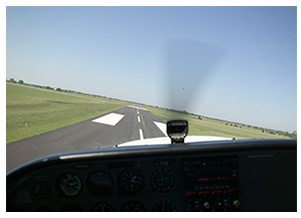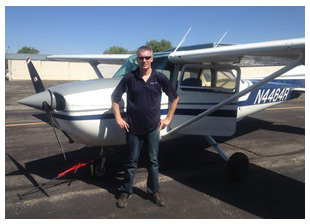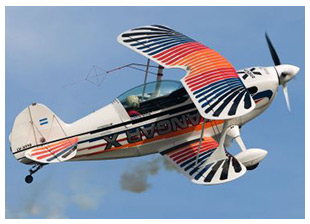Training Tips
|

It's windy today. Whichever runway you select, there will be a crosswind for your takeoffs and landings.
Briefing for the flight with your instructor, you calculate an estimated crosswind component, and review the crosswind-correction methods you have learned. But there's another key piloting decision that will have to be made, and sometimes it gets less attention than whether to perform a crab, a slip, or a crab-and-slip.
"What flap setting do you plan to use?"
Having reviewed your aircraft's pilot's operating handbook the previous evening, you are ready, and explain to your CFI that you may opt for only a partial flap setting, depending on the actual winds while you are flying. The decision, you continue, is based on this passage in your Cessna 172's POH: "When landing in a strong crosswind, use the minimum flap setting required for the field length."
Your analysis is also based on this brief mention of flap settings in the Airplane Flying Handbook's discussion of crosswind landings: "Flaps can and should be used during most approaches since they tend to have a stabilizing effect on the airplane. The degree to which flaps should be extended will vary with the airplane's handling characteristics, as well as the wind velocity."
The CFI is impressed with your preparation, but has another question: "What does field length have to do with it?"
A crosswind landing in strong winds requires the pilot to strike a balance between getting the prompt and precise aircraft responses to control pressures assured by higher approach airspeeds, and making sure not to run out of runway during the touchdown and rollout.
Fortunately, it does not take lots of extra airspeed to get the desired result. Think back to your practice of slow flight. You observed how (and when) control authority decays as you decelerate toward minimum controllable airspeed. You experienced how much yoke and rudder input it takes to overcome the drag produced by flight at such a high angle of attack.
Another difference in technique when landing with partial flaps is the go-around. It will probably be easier to manage. For many aircraft, landing with full flaps requires a partial retraction of flaps immediately after you add power to go around to assure a positive rate of climb. With only partial flaps deployed for landing, the initial climb may require no configuration change, reducing the pilot's workload.
|
|
Flight Training News
|

Article
One pilot estimates he saved $3,000 doing his private pilot training through a flying club.
Read more...
 
Article
Student pilots have the chance to win one of 10 AOPA Flight Training Scholarships, which will be awarded at the AOPA Homecoming Fly-In in October.
Read more...
 
Apps of the week
Five new aviation apps help students study for the private pilot exam, practice holds and radial intercepts, and more.
Read more...
 
Article
It's not too late to sign up for Redbird Flight Simulations' Flying Challenge Cup.
Read more...
 
Article
Southern Illinois University Carbondale's flight team took top honors at the 2014 National Intercollegiate Flying Association's Safety and Flight Evaluation Conference (Safecon).
Read more...
 
Flash-based, login required
Thunderstorms and airplanes don't mix. But if you find yourself near dangerous convective activity, it is critical that you understand how air traffic control can help. The Air Safety Institute's Weather Wise: Thunderstorms and ATC course explains the finer nuances of how to communicate effectively with ATC, how controllers describe precipitation, and what radar services they can offer.
Take the course...
Video
Should you turn your transponder to "standby" when changing codes? See what ATC has to say.
Learn more...
 
|
Training Resources
|
|
For most student pilots, the cross-country phase of training brings a new rush of excitement. All the elements of your training come together as you expand your aeronautical horizons, first with your flight instructor, and then by yourself as you close in on the solo cross-country experience requirement of the pilot certificate that you're pursuing. Check out
these resources from Flight Training magazine.
|
|
Did you know that student pilots who join AOPA are three times more likely to complete their flight training? Membership includes unlimited access to aviation information by phone (800/USA-AOPA, weekdays from 8:30 a.m. to 8 p.m. Eastern time) or from Flight Training Online or AOPA Online. If you're not already a member, join today and get the pilot's edge.
|
AOPA Live
|
|
AOPA Live This Week
Superior Air Parts, AOPA, and the FAA work to get aircraft back in the air with an alternative means of compliance to an airworthiness directive. Plus, take a look at the rare Lockheed PV-2 Harpoon that will be featured at AOPA's Indianapolis Fly-In May 31.
AOPA Live This Week®, May 22...
 
|
|
Career Pilot
|
|
Embry-Riddle Aeronautical University–Worldwide has announced plans to offer a master of science degree in unmanned systems beginning in August. The degree will have concentrations in the following areas: unmanned aerospace system, aeronautics and design, human factors, space systems, safety/emergency response, operations, education, aviation/aerospace management, and aviation/aerospace research.
American Airlines and US Airways on May 5 announced eight new domestic routes. Beginning Sept. 3, US Airways Express will offer twice-daily nonstop flights from Grand Rapids, Mich., to Charlotte, N.C., and Philadelphia using Bombardier CRJ aircraft. Beginning Oct. 2, US Airways Express will offer three daily flights between Charlotte and Evansville, Ind., and one between Charlotte and Fort Wayne, Ind., also using Bombardier CRJs. On the same day, American Eagle will begin service between Chicago and Bismarck, N.D., and between Dallas/Fort Worth and Bismarck, using Embraer ERJ-145 aircraft. US Airways Express will operate twice daily between Philadelphia and Fort Wayne, and US Airways will provide daily service between Phoenix and Cleveland using an Airbus A320.
|
|
For more aviation career news, see the Flight Training website.
|
Plane Spotter
|

It's a beautiful day for an airshow, and the airport is overflowing with participants and spectators. Plane spotting opportunities abound at such times, and you notice that a T-hangar reportedly owned by an aircraft homebuilder has its door open, with a compact two-place biplane parked outside. This is a 200-horsepower Aviat Christen Eagle II (from an aircraft line introduced by Frank Christensen), that soon will be putting on a crowd-pleasing performance with its roll rate of 187 degrees per second, and its positive 6-G and negative 4-G structural limits.
|
Training Products
|
|
The third edition of Air Traffic Control Career Prep is now available at MyPilotStore.com. The book is a comprehensive guide that includes the test preparation for the initial air traffic control exams. Also included in this book are instructions on how to access the ATC Career Prep Software Suite so readers can become familiar with and practice the eight tests in the Air Traffic Selection and Training (AT-SAT) exam. The cost is $44.95.
Banyan Pilot Shop is offering the FAA-approved Touch Trainer Flight Sim. The device offers accurate simulation of aircraft performance, systems, and avionics beyond FAA requirements, which Banyan says enables aircraft-specific instrument and procedure training to keep you sharp and current. The cost is $5,050.
|
|
Note: Products listed have not been evaluated by ePilot editors unless otherwise noted. AOPA assumes no responsibility for products or services listed or for claims or actions by manufacturers or vendors.
|
Member Benefits
|
|
Members only
If you have an accident and a claim against you, certain renter's insurance policies will provide you with legal defense as added protection. This is an important benefit to have. As you may know, attorney fees can range up to more than $400 an hour.
Read more...
 
Members only
Eating certain foods might actually slow down angiogenesis, the formation of new blood vessels, and thereby prevent malignant tumors from surviving.
Read more...
 
|
Blogs
|
|
If you talk to pilots from different airlines, it becomes pretty apparent that they are very different in many ways, and in other ways, they are exactly the same.
Read more...
 
|
Instrument Tip
|

IFR Fix
If your favorite instructor hasn't already called to see if you want to add to your actual-IMC experience (or break into the time category for the first time), reach out.
Read more...
 
|
Final Exam
|
Question
What is maneuvering speed (VA), and how is it significant?
Answer
Maneuvering speed is the speed at which the aircraft can experience abrupt control inputs without causing structural damage. It is an important number to know because it is the maximum speed the aircraft should be flown in turbulent conditions. This speed varies with the weight of the aircraft, and the airspeed range can be found in the aircraft's pilot's operating handbook. (Source: Pilot's Handbook of Aeronautical Knowledge, Chapter 4.)
|
|
Got a question for our technical services staff? Contact AOPA.
|
Career Opportunities
|
|
AOPA career opportunities
Ever dream of turning your passion for aviation into a career? We're looking for a member services representative, associate project manager, major gift officer, AOPA Live producer/videographer I, executive assistant for government affairs, and account manager II. To learn more about other AOPA career opportunities,
visit AOPA Online.
|
 |
Education and Seminars
|
Flight Instructor Refresher Courses
June 7-8 - Santa Clara, Calif.; and Ashburn, Va.
June 21-22 - Charlotte, N.C.; Minneapolis, Minn.; and Orlando, Fla.
June 28-29 - Columbus, Ohio; and Phoenix, Ariz.
July 12-13 - Memphis, Tenn.; and Pittsburgh, Pa.
For a complete schedule, see AOPA Online. Can't make it in person? Sign up for the Air Safety Institute's new Online eFIRC.
|
Rusty Pilot Seminars
May 29 - Batavia, Ohio.
May 30 - Indianapolis, Ind.
May 31 - Santa Paula, Calif.; and Allentown, Pa.
June 7 - Cortland, N.Y.; Riverside, Calif.; Watkins, Colo.; Southbridge, Mass.; and Aurora, Ore.
For a complete schedule, see AOPA Online.
|
|
Aviation Calendar
|
|
Want something to do this weekend? Planning an aviation getaway? See AOPA's enhanced calendar of events. Now you can filter events by date range, airport ID, state, or region. Before you take off on an adventure, make sure you check our current aviation weather provided by Jeppesen.
To include an event or to search all events in the calendar, visit AOPA Online. For airport details, including FBO fuel prices, see AOPA Airports.
AOPA Featured Events
May 31 — Indianapolis, Indiana. Indianapolis Regional Airport (KMQJ). AOPA Fly-In.
Jul 12 — Plymouth, Massachusetts. Plymouth Airport (KPYM). AOPA Fly-In.
Aug 16 — Spokane, Washington. Spokane Felts Field (KSFF). AOPA Fly-In.
Sep 20 — Chino, California. Chino Airport (KCNO). AOPA Fly-In.
Oct 4 — Frederick, Maryland. Frederick Municipal Airport (KFDK). AOPA Homecoming.
Nov 8 — Brunswick, Georgia. Malcom McKinnon Airport (KSSI). AOPA Fly-In.
|
|
|
|
|
|
 |
|
|
ePilot Flight Training Editor:
Benét Wilson
Production Assistant:
Melissa Whitehouse |
Contributors:
Sarah Deener
Alyssa Miller
Jim Moore
Jill W. Tallman
Warren Morningstar
Alton K. Marsh
Dave Hirschman
Tom Horne
Ian J. Twombly
Dan Namowitz |
|
|
|
|